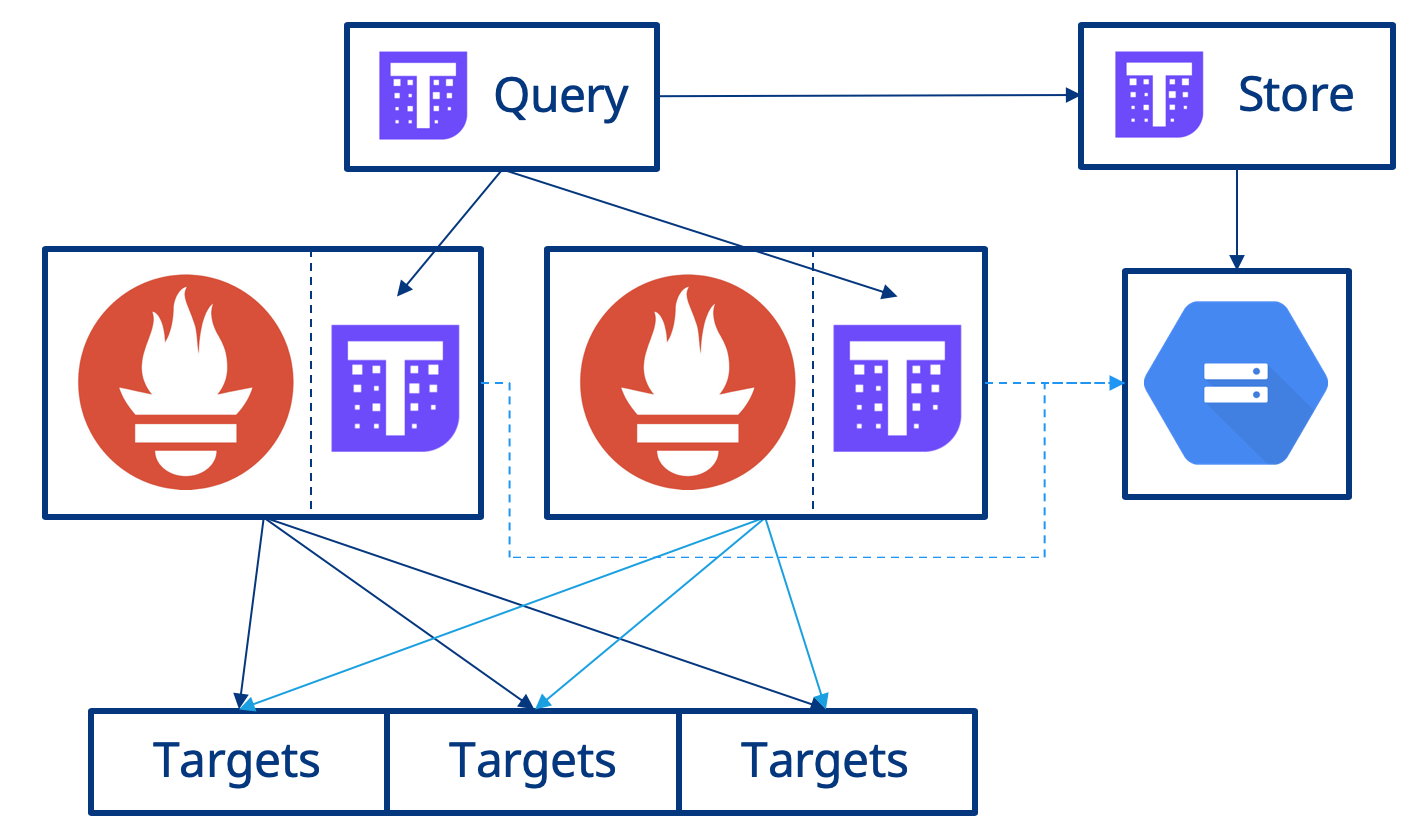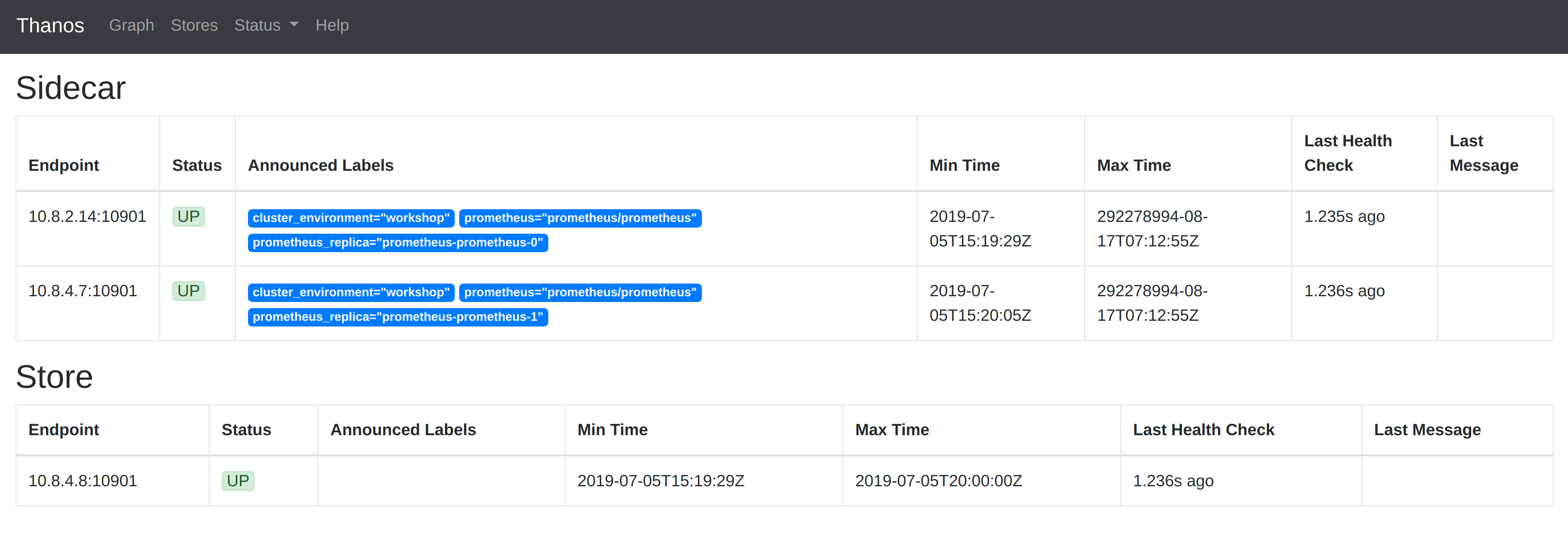Long Term Storage
Long Term Storage
Now that you have enabled high availability with Prometheus using Thanos you can look at the next killer feature of Thanos, long term storage of metrics!
To enable this, you first need to create a bucket on an object store such as AWS S3 or GCP Storage. Next you enable the Thanos Sidecar to upload metrics to the object store. Lastly, you need to deploy another Thanos component called Store that acts as an API for the metrics available in the object store and will be queried by the existing Thanos Query instance when a user executes a Prometheus query via Thanos Query. The diagram below shows this using a GCP Storage bucket.
From the perspective of users they are completely unaware that when they execute a Prometheus query Thanos is querying the for metrics from both the Prometheus instances and from the object storage.
How does this work? Prometheus stores metrics in blocks. Initially, it stores a block in memory however periodically, typically every 2 hours, it writes the current in memory block out to the filesystem. As the Thanos Sidecar in the Prometheus Pod has the same shared filesystem as the Prometheus container it can see the new block that Prometheus writes to the filesystem. Once it sees a new block on disk, the Thanos Sidecar uploads the block to the object storage as per its configuration. This is shown below in the diagram.
Lets now implement this. For this example I created a Google Cloud Storage bucket called observability-for-kubernetes-thanos-demo and provisioned a Service Account with ‘Storage Admin’ permissions so that Thanos can read and write to the storage bucket. In the cloud provider of your choice, create a storage bucket and set of credentials with permission to access the bucket.
We you need to create a Thanos Object Store configuration file that provides the bucket configuration and credentials to Thanos. The structure of this file differs per cloud provider, you can see the Thanos Documenation to see the different options but for this example lets proceed using Google Cloud Platform.
You will create a Kubernetes Secret that contains the GCP Service Account and Bucket Name. The example below shows the expected structure, however the GCP Service Account is not valid for obvious security reasons!
type: GCS
config:
bucket: "observability-for-kubernetes-thanos-demo"
service_account: |-
{
"type": "service_account",
"project_id": "kubernetes-cloud-lab",
"private_key_id": "",
"private_key": "-----BEGIN PRIVATE KEY-----\n\n-----END PRIVATE KEY-----\n",
"client_email": "observability-for-kubernetes@kubernetes-cloud-lab.iam.gserviceaccount.com",
"client_id": "",
"auth_uri": "https://accounts.google.com/o/oauth2/auth",
"token_uri": "https://oauth2.googleapis.com/token",
"auth_provider_x509_cert_url": "https://www.googleapis.com/oauth2/v1/certs",
"client_x509_cert_url": "https://www.googleapis.com/robot/v1/metadata/x509/observability-for-kubernetes%40kubernetes-cloud-lab.iam.gserviceaccount.com"
}
You should take the valid version of the example above and base64 encode it. You can use base64 in your terminal for doing this. Then create a file called thanos-object-secret.yaml and include the Kubernetes Secret, as shown below:
---
apiVersion: v1
kind: Secret
metadata:
name: thanos-config
namespace: prometheus
data:
thanos.config: dHlwZTogR0NTCmNvbmZpZzoKICBidWNrZXQ6ICJvYnNlcnZhYmlsaXR5LWZvci1rdWJlcm5ldGVzLXRoYW5vcy1kZW1vIgogIHNlcnZpY2VfYWNjb3VudDogfC0KICB7CiAgICAidHlwZSI6ICJzZXJ2aWNlX2FjY291bnQiLAogICAgInByb2plY3RfaWQiOiAia3ViZXJuZXRlcy1jbG91ZC1sYWIiLAogICAgInByaXZhdGVfa2V5X2lkIjogIiIsCiAgICAicHJpdmF0ZV9rZXkiOiAiLS0tLS1CRUdJTiBQUklWQVRFIEtFWS0tLS0tXG5cbi0tLS0tRU5EIFBSSVZBVEUgS0VZLS0tLS1cbiIsCiAgICAiY2xpZW50X2VtYWlsIjogIm9ic2VydmFiaWxpdHktZm9yLWt1YmVybmV0ZXNAa3ViZXJuZXRlcy1jbG91ZC1sYWIuaWFtLmdzZXJ2aWNlYWNjb3VudC5jb20iLAogICAgImNsaWVudF9pZCI6ICIiLAogICAgImF1dGhfdXJpIjogImh0dHBzOi8vYWNjb3VudHMuZ29vZ2xlLmNvbS9vL29hdXRoMi9hdXRoIiwKICAgICJ0b2tlbl91cmkiOiAiaHR0cHM6Ly9vYXV0aDIuZ29vZ2xlYXBpcy5jb20vdG9rZW4iLAogICAgImF1dGhfcHJvdmlkZXJfeDUwOV9jZXJ0X3VybCI6ICJodHRwczovL3d3dy5nb29nbGVhcGlzLmNvbS9vYXV0aDIvdjEvY2VydHMiLAogICAgImNsaWVudF94NTA5X2NlcnRfdXJsIjogImh0dHBzOi8vd3d3Lmdvb2dsZWFwaXMuY29tL3JvYm90L3YxL21ldGFkYXRhL3g1MDkvb2JzZXJ2YWJpbGl0eS1mb3Ita3ViZXJuZXRlcyU0MGt1YmVybmV0ZXMtY2xvdWQtbGFiLmlhbS5nc2VydmljZWFjY291bnQuY29tIgogIH0=
The value of thanos.config should be set to the base64 string that was just generated.
Apply thanos-object-secret.yaml to Kubernetes by executing kubectl apply -f thanos-object-secret.yaml:
$kubectl apply -f thanos-object-secret.yaml
secret/cluster-thanos-config created
With the object store configuration deployed to Kubernetes, next update the Prometheus resource adding the objectStorageConfig key so that the Prometheus Operator configures the Thanos Sidecar with the object storage config that has just been deployed to Kubernetes.
The Prometheus resource should look similar to the below with this added:
---
apiVersion: monitoring.coreos.com/v1
kind: Prometheus
metadata:
name: prometheus
namespace: prometheus
spec:
affinity:
podAntiAffinity:
preferredDuringSchedulingIgnoredDuringExecution:
- weight: 100
podAffinityTerm:
labelSelector:
matchExpressions:
- key: app
operator: In
values:
- prometheus
topologyKey: kubernetes.io/hostname
baseImage: quay.io/prometheus/prometheus
logLevel: info
podMetadata:
annotations:
cluster-autoscaler.kubernetes.io/safe-to-evict: "true"
labels:
app: prometheus
thanos-store-api: "true"
replicas: 2
thanos:
version: v0.4.0
resources:
limits:
cpu: 500m
memory: 500Mi
requests:
cpu: 100m
memory: 500Mi
objectStorageConfig:
key: thanos.config
name: thanos-config
resources:
limits:
cpu: 1
memory: 2Gi
requests:
cpu: 1
memory: 2Gi
retention: 12h
serviceAccountName: prometheus-service-account
serviceMonitorSelector:
matchLabels:
serviceMonitorSelector: prometheus
externalLabels:
cluster_environment: workshop
storage:
volumeClaimTemplate:
apiVersion: v1
kind: PersistentVolumeClaim
metadata:
name: prometheus-pvc
spec:
accessModes:
- ReadWriteOnce
resources:
requests:
storage: 10Gi
version: v2.10.0
Edit the prometheus.yaml file you created previously to reflect the changes above. Under the objectStorageConfig key set the name to be the name of the Kubernetes Secret you just created and the key to be the name of the secret key you used, which in this case is thanos.config.
Apply the updated prometheus.yaml to Kubernetes by running kubectl apply -f prometheus.yaml. To see an example of the full YAML file that reflects the changes described above see here.
Once the Prometheus Pods have restarted with the new configuration, use kubectl logs to view the logs from the thanos-sidecar container in one of the Prometheus Pods, as shown below:
$kubectl logs prometheus-prometheus-0 thanos-sidecar --namespace prometheus
level=info ts=2019-07-05T20:48:04.403642465Z caller=flags.go:87 msg="gossip is disabled"
level=info ts=2019-07-05T20:48:04.403893193Z caller=main.go:257 component=sidecar msg="disabled TLS, key and cert must be set to enable"
level=info ts=2019-07-05T20:48:04.403923795Z caller=factory.go:39 msg="loading bucket configuration"
level=info ts=2019-07-05T20:48:04.404486705Z caller=sidecar.go:319 msg="starting sidecar" peer="no gossip"
level=info ts=2019-07-05T20:48:04.404636222Z caller=main.go:309 msg="Listening for metrics" address=0.0.0.0:10902
level=info ts=2019-07-05T20:48:04.404674065Z caller=reloader.go:154 component=reloader msg="started watching config file and non-recursively rule dirs for changes" cfg= out= dirs=
level=info ts=2019-07-05T20:48:04.40474036Z caller=sidecar.go:260 component=sidecar msg="Listening for StoreAPI gRPC" address=[10.8.2.14]:10901
level=info ts=2019-07-05T20:48:06.414276291Z caller=sidecar.go:176 msg="successfully loaded prometheus external labels" external_labels="{cluster_environment=\"workshop\",prometheus=\"prometheus/prometheus\",prometheus_replica=\"prometheus-prometheus-0\"}"
level=info ts=2019-07-05T20:48:34.441923855Z caller=shipper.go:350 msg="upload new block" id=01DF1NSPGCHYM8T82R8BKAX4HP
level=info ts=2019-07-05T20:48:35.12152462Z caller=shipper.go:350 msg="upload new block" id=01DF1R3VHXY2NA2ZH4W4TVM33H
level=info ts=2019-07-05T21:00:04.457140171Z caller=shipper.go:350 msg="upload new block" id=01DF1YZJT0GNZ2G0YWJWJ3NE25
If your instances of Prometheus have been running long enough (atleast 2 hours) there should be a block on the filesystem ready to be uploaded. If there is, you will see it upload the block to the storage bucket as shown above. See the log entry “upload new block” where it begins the upload. If you check the bucket in the cloud provider console you will the blocks are now present.
Thanos Components
Now that the Thanos Sidecar is uploading blocks to the object store, we need to deploy two addtional components: Thanos Store and Thanos Compact.
Thanos Store
Thanos Store acts as an API for querying Prometheus metrics stored in the object store.
Update prometheus.yaml to also include the following:
---
apiVersion: apps/v1
kind: StatefulSet
metadata:
name: thanos-store
namespace: prometheus
labels:
app: thanos-store
thanos-store-api: "true"
spec:
replicas: 1
serviceName: thanos-store
selector:
matchLabels:
app: thanos-store
thanos-store-api: "true"
template:
metadata:
labels:
app: thanos-store
thanos-store-api: "true"
spec:
containers:
- name: thanos-store
image: improbable/thanos:v0.5.0
resources:
limits:
cpu: 1
memory: 1Gi
requests:
cpu: 500m
memory: 1Gi
args:
- "store"
- "--data-dir=/prometheus/cache"
- "--objstore.config-file=/config/thanos.config"
- "--log.level=info"
- "--index-cache-size=256MB"
- "--chunk-pool-size=256MB"
- "--store.grpc.series-max-concurrency=30"
ports:
- name: http
containerPort: 10902
- name: grpc
containerPort: 10901
- name: cluster
containerPort: 10900
volumeMounts:
- mountPath: /prometheus
name: thanos-store-storage
- mountPath: /config/
name: thanos-config
volumes:
- name: thanos-config
secret:
secretName: thanos-config
volumeClaimTemplates:
- metadata:
name: thanos-store-storage
spec:
accessModes: [ "ReadWriteOnce" ]
resources:
requests:
storage: 10Gi
Apply this to Kubernetes by running kubectl apply -f prometheus.yaml.
Kubernetes will launch a single Thanos Store Pod as per the configuration above. If you check the available Stores in the Thanos Query UI, you will now see Thanos Store listed in addition to the two Thanos Sidecars running alongside Prometheus. Now when querying via Thanos Query, the query will execute across both the Prometheus instances and also the metrics stored in the object store!
Thanos Compact
Thanos Compact is the final Thanos component you need to deploy.
Compact performs three main tasks:
- It executes a Prometheus compaction job on the blocks in the object store. Typically Prometheus would execute this for blocks locally on the filesystem but the process is disabled by Prometheus Operator when using Thanos.
- It also executes a down-sampling process on metrics in the object store. Prometheus stores metrics with a resolution of 1 minute. However, if you were to execute a query over a period of months or years on a Prometheus environment using Thanos with long term storage, the number of data-points returned would be excessive! Therefore, Compact performs the down-sampling job adding a 5 minute and 1 hour sample in addition to the 1 minute sample. It does this by creating a new block and discarding the original once down-sampling is completed. When executing queries, Thanos will automatically select the most appropriate sample to return.
- Lastly, it is also possible to set retention periods for the 1 minute, 5 minute and 1 hour samples. Compact will apply these retentions if they are set.
Now lets deploy Thanos Compact.
Update prometheus.yaml to also include the following:
---
apiVersion: apps/v1
kind: StatefulSet
metadata:
name: thanos-compact
namespace: prometheus
labels:
app: thanos-compact
spec:
replicas: 1
serviceName: thanos-compact
selector:
matchLabels:
app: thanos-compact
template:
metadata:
labels:
app: thanos-compact
spec:
containers:
- name: thanos-compact
image: improbable/thanos:v0.5.0
resources:
limits:
cpu: 1
memory: 1Gi
requests:
cpu: 500m
memory: 1Gi
args:
- "compact"
- "--data-dir=/prometheus/compact"
- "--objstore.config-file=/config/thanos.config"
- "--log.level=info"
- "--retention.resolution-raw=2d"
- "--retention.resolution-5m=5d"
- "--retention.resolution-1h=10d"
- "--consistency-delay=15m"
- "--wait"
ports:
- name: http
containerPort: 10902
- name: grpc
containerPort: 10901
- name: cluster
containerPort: 10900
volumeMounts:
- mountPath: /prometheus
name: thanos-compact-storage
- mountPath: /config/
name: thanos-config
volumes:
- name: thanos-config
secret:
secretName: thanos-config
volumeClaimTemplates:
- metadata:
name: thanos-compact-storage
spec:
accessModes: [ "ReadWriteOnce" ]
resources:
requests:
storage: 10Gi
Apply this to Kubernetes by running kubectl apply -f prometheus.yaml.
Kubernetes will launch a single Thanos Compact Pod which will, once running, start performing the actions described above on blocks stored in the object store.
To see an example of the full YAML file that reflects the changes described above with Thanos Store and Compact see here.


